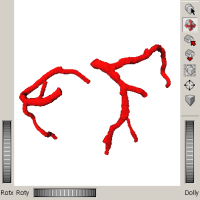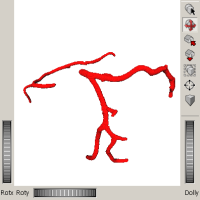Coronary Artery Segmentation
The challenges for coronary artery segmentation are comparable to those for the tracking of coronary arteries. Stenoses or motion artifacts may lead to a premature termination of the segmentation process whereas crossing of adjacent structures with similar intensity characteristics may lead to a leakage of the segmentation process into these undesired regions. Therefore, constraints about the tubular anatomical shape of the coronary arteries are often included in the segmentation process.
For the segmentation of the coronary arteries, we used a graph-cut approach, because graph-cuts have shown to be robust and only few parameters are needed for their adoption to specific problems. The graph-cut algorithm was combined with a shape-prior and a prunning process. For the segmentation, the tracked coronary artery tree was reformatted along its path.


